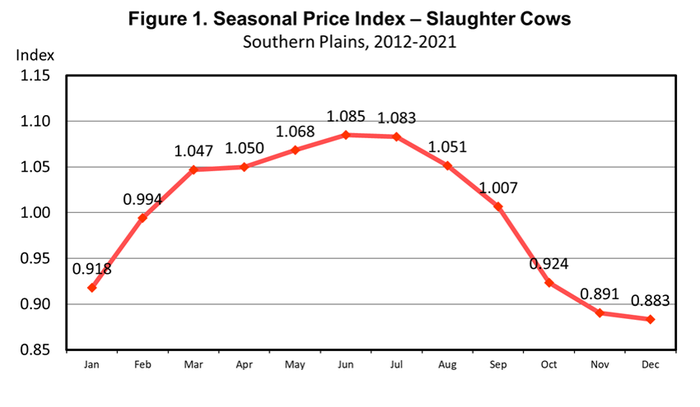
As of mid-September, cull cow prices at Oklahoma auctions are an average of 33.1 percent higher year over year across all grades and dressing percentages. Higher slaughter cow prices are the result of strong lean beef markets and the related growth in breeding demand for cows.
Beef cow slaughter increased annually from 2015 – 2022 and, after rising sharply the past two years to the highest level since 1996, is declining year over year in 2023. Beef cow slaughter is falling more sharply in the second half of this year and may end the year down in the range of 15-17 percent from year earlier levels. The declining supply of lean beef is driving higher processing beef prices. The current price of 90 percent lean beef is 17.3 percent higher year over year.
With fall culling decisions approaching, producers should be aware of factors affecting cull cow value and consider opportunities to increase cull value. Table 1 shows the average percent difference in price of slaughter cows compared to a base of average dressing, Boner cows. The price of average dressing Boner cows in mid-September is $108.38/cwt. which means that the prices would be expected to vary from a high of $120.74/cwt. for high dressing Breaker cows to a low of $91.80/cwt. for low dressing Lean cows.
Table 1. Impact of Grade and Dressing Percentage on Slaughter Cow Value.
Dressing Grade | High | Average | Low |
Breaker | +11.4 % | +5.1 % | -2.2 % |
Boner | +5.6 % | BASE | -8.0 % |
Lean | -0.9 % | -6.6 % | -15.3 % |
Slaughter cow grade is a function of age, weight, and condition of cows. The Agricultural Marketing Service (USDA-AMS) uses the following guidelines to grade slaughter cows:
Breaker: Slaughter cows expected to yield carcasses in the range of 75-80% lean. Typically, a cow with more than .35 inch of backfat at the 12th rib.
Boner: Slaughter cows expected to yield carcasses in the range of 80-85% lean. Typically, a cow with between .15-.35 inches of backfat at the 12th rib.
Lean: Slaughter cows expected to yield carcasses in the range of 85+% lean. Typically, a cow with less than .15 inch of backfat at the 12th rib.
As a rough guide, cows will be about 100 pounds heavier for increases in each grade from Lean to Boner to Breaker. Each grade increase is roughly equivalent to an increase of one body condition score. Additionally, the live weight of cows will change by roughly 25-30 pounds above and below the weight of average dressing cows for high and low dressing cows. Producers can often impact the value of cull cows by managing the weight and condition of cows before marketing.
Cull cows have the most pronounced seasonal price pattern of any class of cattle ranging from highs in June and July to lows in November and December (Figure 1). Cull cows that are thin (Lean, low dressing) in the fall and are retained and fed until spring may sell as Boner cows at average dressing by March with an increase in value of $400-$600/head due to added weight, grade, and condition. Of course, the feasibility of holding cull cows depends on time and management considerations and the availability of surplus feed.

Going forward, many culled cows will likely be screened for the possibility of producing another calf and selling later for slaughter value. Leaving the cull cows with a bull while adding weight after weaning may produce another increment of added value if she can be sold as a bred cow next spring at seasonally high bred cow prices.
About the Author(s)
You May Also Like




